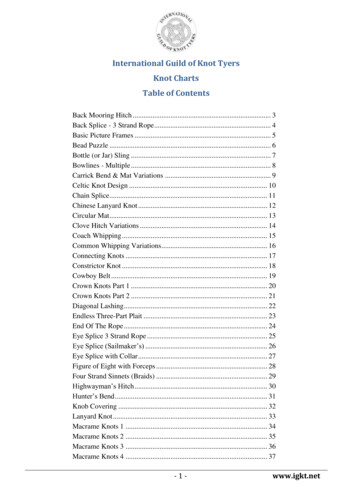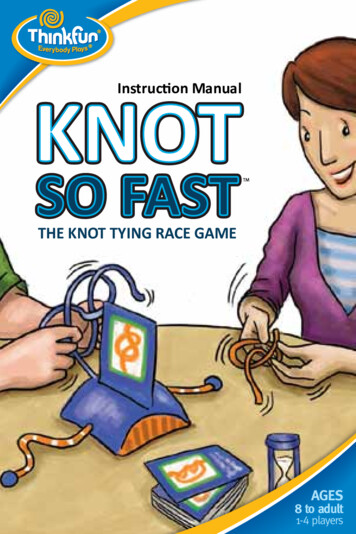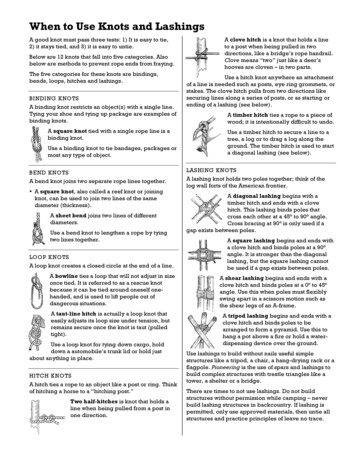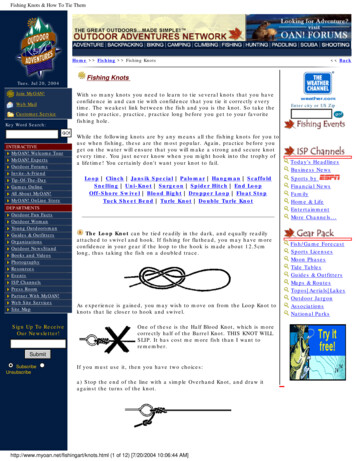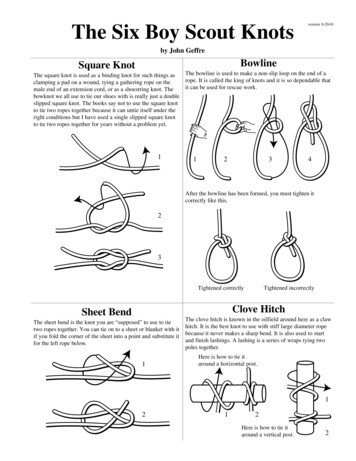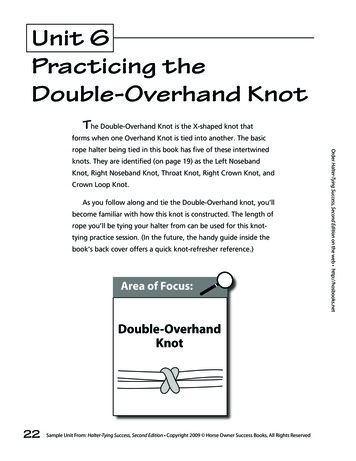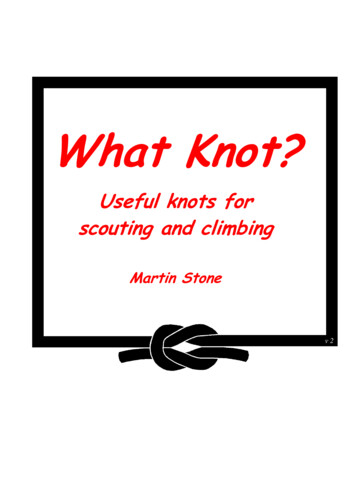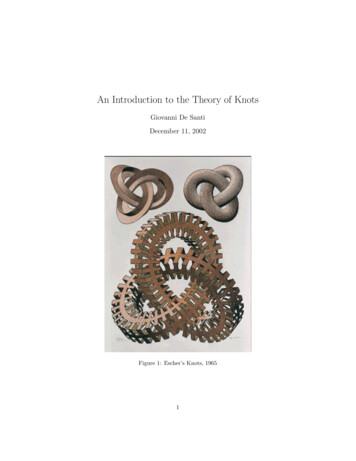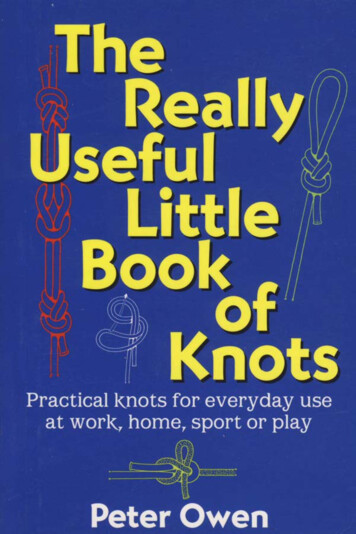
Transcription
Tiger and WolfKnot InstructionMaterials:A rope for each Cub Scout that is 2 1/2 to 3 feet longTiger/Wolf instruction sheetsInstructions:Tiger rank does not have any knot tying requirements, however, these membersof the Tiger den can learn what the members of the Wolf den need to learn.Overhand KnotAn overhand knot is simple. You can use it to keep a rope from going through apulley, a hole, or to make a rope easier to grip. An overhand knot is also the firststep for some other knots. You will need a single strand of rope to practice thisknot. (Wolf Handbook, page 36)121. First make a loop in the end of the rope.2. Next, tuck the end of the rope through the loop.3. Pull the end of the rope to tighten the knot.3
Square KnotThe main use of a square knot is to join the ends or two ropes. This is why it iscalled the joining knot in Scouting. You can use both ends of one rope to make asquare knot or two different pieces of rope.1. Hold one end of a rope in one hand and the other end of the rope in your otherhand. (Or a different colored rope in each hand.)2. Bring the right side rope over the left side rope. Go under and around the leftside rope with the right side rope.3. Now bring the left side rope over the right side rope. Go under and around theright side rope with the left side rope.4. Pull both ends firmly. The knot will not hold its shape without being tightened.(Wolf Handbook, page 37)
Tiger and WolfKnot Instruction SheetOverhand KnotAn overhand knot is simple. You can use it to keep a rope from going through apulley, a hole, or to make a rope easier to grip. An overhand knot is also the firststep for some other knots. You will need a single strand of rope to practice thisknot. (Wolf Handbook, page 36)121. First make a loop in the end of the rope.2. Next, tuck the end of the rope through the loop.3. Pull the end of the rope to tighten the knot.3
Square KnotThe main use of a square knot is to join the ends or two ropes. This is why it iscalled the joining knot in Scouting. You can use both ends of one rope to make asquare knot or two different pieces of rope.1. Hold one end of a rope in one hand and the other end of the rope in your otherhand. (Or a different colored rope in each hand.)2. Bring the right side rope over the left side rope. Go under and around the leftside rope with the right side rope.3. Now bring the left side rope over the right side rope. Go under and around theright side rope with the left side rope.4. Pull both ends firmly. The knot will not hold its shape without being tightened.(Wolf Handbook, page 37)
Bear and WebelosKnot InstructionMaterials:A rope for each Cub Scout that is 2½ to 3 feet longBear/Webelos instruction sheetsInstructions:Use the following instructions for members of the Bear dens, Webelos dens and Arrow of Lightdens.Review tying overhand knots and square knots (see Tiger/Wolf instruction sheet). The ScoutingAdventure (required for Arrow of Light) requires that Webelos Scouts show how to tie asquare knot, two half hitches and a taut-line hitch. The Bear Necessities Adventure requiresBear Scouts to tie a Bowline and then to teach a younger Scout how to tie it.Two Half HitchesThe two half hitches knot is used to tie items to a post or tree trunk. The knot is easy to untiewhen you are ready, but it will hold tight while in use. Each wrap around the rope is called ahalf hitch. Making two of them around the rope is what gives this hitch its name.1. Pass the end of the rope around the post.2. Bring the end over and under the body of the rope (known as the standing part), then backthrough the loop that has formed. This makes a half hitch.3. Take the end around the standing part a second time, and tie another half hitch.4. Pull the knot snug.
BowlineA bowline is a very useful knot to learn. It makes a fixed loop in a rope that will not slip. Thebowline can be used to anchor one end of a rope to a tree or other stationary object. Onceyou have mastered the bowline, teach it to a younger Cub Scout.1. Make a small overhand loop in the standing part of the rope.2. Bring the rope end up through the loop, around behind the standing part, and back downinto the loop.3. Tighten the bowline by pulling the standing part of the rope away from the loop.Taut-Line HitchA taut line hitch is similar to two half hitches, but it creates a loop that doesn’t slide. Use it toattach the guy line on your tent or dining fly to a stake in the ground. You can easily adjust it totighten the rope. (Taut is another word for tight.1. Pass the end of the rope around the tent stake (or post).2. Bring the end under and overthe standing part of the line toform a loop, then twice throughthe loop.3. Again bring the rope end under,over and through a loop, but this time farther up the standing part.
Bear and WebelosKnot Instruction SheetTwo Half HitchesThe two half hitches knot is used to tie items to a post or tree trunk. The knot iseasy to untie when you are ready, but it will hold tight while in use. Each wraparound the rope is called a half hitch. Making two of them around the rope iswhat gives this hitch its name.1. Pass the end of the rope around the post.2. Bring the end over and under the body of the rope (known as the standingpart), then back through the loop that has formed. This makes a half hitch.3. Take the end around the standing part a second time, and tie another halfhitch.4. Pull the knot snug.BowlineA bowline is a very useful knot to learn. It makes a fixed loop in a rope that willnot slip. The bowline can be used to anchor one end of a rope to a tree or otherstationary object. Once you have mastered the bowline, teach it to a younger CubScout.
1. Make a small overhand loop in the standing part of the rope.2. Bring the rope end up through the loop, around behind the standing part, andback down into the loop.3. Tighten the bowline by pulling the standing part of the rope away from theloop.Taut-Line HitchA taut line hitch is similar to two half hitches, but it creates a loop that doesn’tslide. Use it to attach the guy line on your tent or dining fly to a stake in theground. You can easily adjust it to tighten the rope. (Taut is another word fortight.1. Pass the end of the rope around the tent stake (or post).2. Bring the end under and over the standing part of the line to form a loop, thentwice through the loop.3. Again bring therope end under, overand through a loop,but this time fartherup the standing part.
An overhand knot is simple. You can use it to keep a rope from going through a pulley, a hole, or to make a rope easier to grip. An overhand knot is also the first step for some other knots. You will need a single strand of rope to practice this knot. (Wolf Handbook, page 36) 1 2 3 1. Firs
